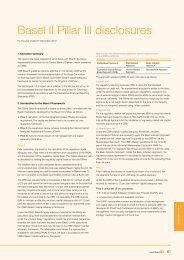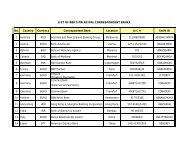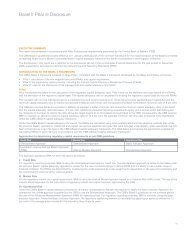BBK annual report eng 21.5.5
BBK annual report eng 21.5.5
BBK annual report eng 21.5.5
You also want an ePaper? Increase the reach of your titles
YUMPU automatically turns print PDFs into web optimized ePapers that Google loves.
3 Significant accounting policies (continued)TaxationThere is no tax on corporate income in the Kingdom of Bahrain. Taxation on foreign operations is provided in accordance with the fiscal regulationsof the respective countries in which the Group operates.With respect to foreign units deferred income taxation is provided using the liability method on all temporary differences at the balance sheet date.Deferred income tax assets and liabilities are measured at the tax rates that are expected to apply to the period when the asset is realised or theliability is settled, based on laws that have been enacted at the balance sheet date.The carrying amount of deferred income tax assets is reviewed at each balance sheet date and reduced to the extent that it is no longer probablethat sufficient taxable profit will be available to allow all or part of the deferred income tax asset to be utilised.Employees' end of service benefitsCosts relating to employees’ end of service benefits are accrued in accordance with actuarial and other valuations as required by regulationsapplicable in each location.ProvisionsProvisions are recognised when the Group has a present obligation (legal or constructive) and the costs to settle the obligation are both probableand able to be reliably measured.Treasury stockTreasury stock is stated at cost.DerivativesThe Group enters into derivative instruments including futures, forwards, swaps, and options in the foreign exchange and capital markets. Derivativesare stated at fair value. Derivatives with positive market values (unrealised gains) are included in other assets and derivatives with negative marketvalues (unrealised losses) are included in other liabilities in the consolidated balance sheet.For the purposes of hedge accounting, hedges are classified into two categories: (a) fair value hedges which hedge the exposure to changes in thefair value of a recognised asset or liability; and (b) cash flow hedges which hedge exposure to variability in cash flows that is either attributable to aparticular risk associated with a recognised asset or liability or a forecasted transaction.In relation to fair value hedges, which meet the conditions for hedge accounting, any gain or loss from remeasuring the hedging instrument to fairvalue is recognised immediately in the consolidated income statement. The hedged item is adjusted for fair value changes and the difference relatingto the risk being hedged is recognised in the consolidated income statement.In relation to cash flow hedges which meet the conditions for hedge accounting the portion of the gain or loss on the hedging instrument that isdetermined to be an effective hedge is recognised initially in equity and the ineffective portion is recognised in the consolidated income statement. Thegains or losses on effective cash flow hedges recognised initially in equity are either transferred to the consolidated income statement in the period inwhich the hedged transaction impacts the consolidated income statement or included in the initial measurement of the cost of the related asset or liability.For hedges which do not qualify for hedge accounting, any gains or losses arising from changes in the fair value of the hedging instrument are takendirectly to the consolidated income statement for the period. Hedge accounting is discontinued when the hedging instrument expires or is sold,terminated or exercised, or no longer qualifies for hedge accounting. For effective fair value hedges of financial instruments with fixed maturities anyadjustment arising from hedge accounting is amortised over the remaining term to maturity. For effective cash flow hedges, any cumulative gain orloss on the hedging instrument recognised in equity remains in equity until the hedged transaction occurs. If the hedged transaction is no longerexpected to occur, the net cumulative gain or loss recognised in equity is transferred to the consolidated income statement.Certain derivatives embedded in other financial instruments are treated as separate derivatives when their economic characteristics and risks arenot closely related to those of the host contract and the host contract is not carried at fair value through the income statement. These embeddedderivatives are measured at fair value with the changes in fair value recognised in the income statement.Annual Report 2004 40 | 41
















